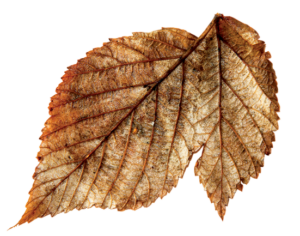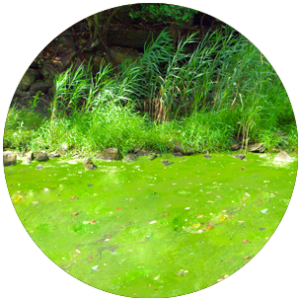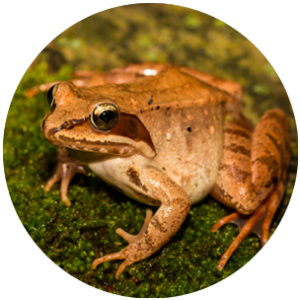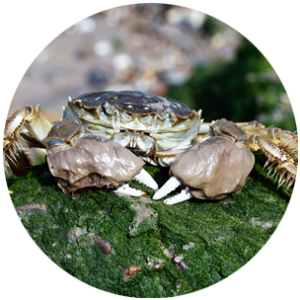In Her Element
Neither rain, nor snow, nor sleet, nor darkness of night shall keep the conservation biologist from collecting data and conducting research.
Indeed, Megan Rothenberger ’02 and members of her “lab family” (as she calls her student research team) actively watch and document changes occurring in their environments of study year-round.
 Whether it’s collecting water samples from Bushkill Creek in below-freezing January temps, trudging through February snow to monitor vernal pools in Jacobsburg State Park, or venturing out after darkness falls to measure light pollution in 18 different Lehigh Valley locations, Rothenberger enjoys introducing her students to the roll-up-your-sleeves, get-your-hands-dirty aspect of her discipline.
Whether it’s collecting water samples from Bushkill Creek in below-freezing January temps, trudging through February snow to monitor vernal pools in Jacobsburg State Park, or venturing out after darkness falls to measure light pollution in 18 different Lehigh Valley locations, Rothenberger enjoys introducing her students to the roll-up-your-sleeves, get-your-hands-dirty aspect of her discipline.
“Some of the most important qualities for a conservation biologist are grit, perseverance, and willingness to observe nature—always! Students often say in my class evaluations something like, ‘Well, conservation sure isn’t glamorous!’”
What her work might lack in glamour, it makes up for with relevance. The practical, problem-solving nature of the field attracted Rothenberger when she was a biology student at Lafayette.
Rothenberger remembers losing interest when her classes focused on theory without application. “There were times I wondered, ‘Why are we doing this? There are so many problems; how is this helping?’”
Her attitude shifted when she took environmental biology with Nancy McCreary Waters, associate professor of biology. “Her whole class was all about problem-solving and using research to help communities,” she says. “That was what I was looking for—the collaborative and application part of science.”
Another turning point for Rothenberger was her decision to switch from a Bachelor of Science to a Bachelor of Arts, requiring more courses in liberal arts subjects. Rothenberger says her exposure to anthropology and sociology was particularly impactful. “I took three courses with Prof. Andrea Smith, who used fieldwork and emphasized making observations about human behavior and applying those findings to address human problems.”
 Today, that’s what defines Rothenberger’s work as a conservation biologist. Much of the data Rothenberger collects is shared with park managers, community members, local conservation organizations, and policymakers so that restoration and management decisions can be made to protect a species or habitat. Unlike other scientific fields that claim to deal with objective facts rather than values, conservation biologists value biodiversity and apply their research findings to protecting it.
Today, that’s what defines Rothenberger’s work as a conservation biologist. Much of the data Rothenberger collects is shared with park managers, community members, local conservation organizations, and policymakers so that restoration and management decisions can be made to protect a species or habitat. Unlike other scientific fields that claim to deal with objective facts rather than values, conservation biologists value biodiversity and apply their research findings to protecting it.
“One of our goals is to use our knowledge to come up with practical plans for restoring and conserving ecosystems,” she says. “A practical plan is one that is feasible and effective, and we are most effective when we work together. Major environmental issues of our time and threats to biodiversity—habitat loss, climate change, invasive species—cross boundaries. So, in my field, we have to be willing to reach outside our silos and work with others in order to achieve all our goals.”

Nikki Morley ’21 is working on an honors thesis in which she is studying the impact of pollution on red-backed salamanders.
Being able to collaborate with others and contribute solutions isn’t only what attracted Rothenberger to conservation. It’s also what attracted her to teaching. Rothenberger benefited from mentorship as a student, and she pays that forward in part through her close-knit lab family, the students who collaborate with her out in the field and in her Rockwell Integrated Sciences Center lab.
“I came to Lafayette not very sure what I wanted to do for a career,” says Nikki Morley ’21. “I didn’t think I’d do anything in biology, and I wasn’t really interested in doing research. Then I took a conservation biology course with Doc R. I was invigorated. Now I am working on an honors thesis with Doc R. Joining her lab has helped me understand how a lab dynamic should work, and it’s given me confidence in my own abilities. I can’t picture my future without a career that involves research and fieldwork.”
Rothenberger, who is now chairing the College’s environmental sciences and studies program, points out the learning is a two-way street. Many students, driven by their own curiosities, propose research projects outside Rothenberger’s area of focus. “A lot of my students suggest a completely new direction—like studying an invasive crab—and I’m like, ‘Wow, I don’t know anything about that, let’s do it!’”
That enthusiasm for exploring, discovering,and collaborating fuels Rothenberger’s work as a teacher, mentor, and scholar.
 Studying Harmful Algae
Studying Harmful Algae
Since joining Lafayette as a faculty member in 2009, Rothenberger has monitored the water quality of several areas, including the Hudson-Raritan Estuary in New York, where she looked at excessive algal growth. “Nutrients like nitrogen and phosphorus can become so excessive in aquatic ecosystems that they become a contaminant,” she says. “They will stimulate algal growth to an extent that when the algae is decomposing, it sucks the oxygen out of the water, which can cause fish kills. These nutrients can also stimulate certain kinds of algae, many of which have toxins.” Although COVID-19 interrupted her monitoring at that site, Rothenberger successfully amassed 10 years of data, which she will submit for publication.
 Prepping for Dam Removal
Prepping for Dam Removal
Closer to campus, Rothenberger collaborates with David Brandes, professor of civil and environmental engineering, and Dru Germanoski, professor of geology, to monitor water quality of Bushkill Creek. Several Bushkill dams are slated for removal, which will restore biodiversity in the stream. “It’s rare for water quality, biota, and sediments to be monitored for multiple years before a dam is removed,” she says. “Usually, it only occurs right before and after a dam is removed, and then there isn’t much of a data set to compare it to. There are very few studies that are this collaborative and have so many years of data. This is such a long-range project that it will provide research opportunities to my students until I retire.”
Understanding Changing Habitats
 Rothenberger’s research interests also entail monitoring vernal pools, important amphibian habitats. Her lab started with five pools; now they study 15. At Jacobsburg State Park in Nazareth, Pa., she has investigated the impact of road proximity, canopy cover, and soil acidity on the wood frog and woodland salamander in the park. In 2021, Rothenberger and Morley are continuing to study the impact road salt has on this habitat.
Rothenberger’s research interests also entail monitoring vernal pools, important amphibian habitats. Her lab started with five pools; now they study 15. At Jacobsburg State Park in Nazareth, Pa., she has investigated the impact of road proximity, canopy cover, and soil acidity on the wood frog and woodland salamander in the park. In 2021, Rothenberger and Morley are continuing to study the impact road salt has on this habitat.
 Stopping an Invasive Species
Stopping an Invasive Species
In December 2020, Rothenberger’s research on two invasive crabs, the Asian shore crab and Chinese mitten crab, was published in the journal Conservation Biology. “The Chinese mitten crab is one of the worst aquatic invasive species of all time,” she explains. “It has caused millions of dollars of damage in Europe, where it became so abundant that it damaged stream banks and levees, and destroyed fishing equipment.” After the Chinese mitten crab was introduced to the Hudson-Raritan Estuary in 2007, anglers and community members were concerned that the crab would become invasive here.”
The collaborative approach Rothenberger took to this invasive-crab data collection became the focus of the published paper. “We started to collect data in 2011 and worked with Trent Gaugler, associate professor of mathematics, and Andrea Armstrong, assistant professor of environmental science and studies. We realized our research team couldn’t do the monitoring alone. We needed to interview community members, anglers, and crabbers, and add that information to our dataset. The message of the paper is how important collaboration is: The scientist couldn’t do this work alone.”